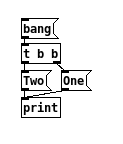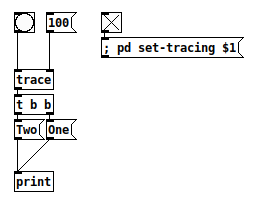@ddw_music All that stuff about instruction pointers and the like was me getting turned around and falling back onto Fourth because that is where my mind goes when I think about stacks. In pd there is no instruction pointer so never any need to return or backtrack or goto. In pd's core, every internal and external object is a literal OOP object and the inlets and outlets are methods of that object. When we create a new object pd creates a new C object of that type and makes an entry for it in glist with its pointer and UI details; when we connect a wire to its outlet pd retrieves the pointers to those objects from the glist and then goes through the outlet method. I am not quite sure how it deals with reaching the end of the branch, I suspect that the last object always has its outlet method run to point it at the branch point and when we append a new object pd just passes that to the new object when it updates the previous end of chain object's outlet method to be the new object.
Some details there might be a tad off, I am not quite good enough with C pointers to really follow pd's source yet, but I am fairly sure that is the mechanics of it. I have no idea about how Max handles this stuff but I would assume it is quite similar.






 They're structured, provide a convenient way for exiting deeply nested loops, and feel similar to Java's exception framework.
They're structured, provide a convenient way for exiting deeply nested loops, and feel similar to Java's exception framework. well, there's a time and place for everything. There are gotos in SuperCollider's C++ codebase, iirc mainly in the long
well, there's a time and place for everything. There are gotos in SuperCollider's C++ codebase, iirc mainly in the long